
This church was built in 1843, and was the first Catholic parish created after the Old Cathedral. Originally it was a French language parish, but soon German immigrants flooded into Saint Louis following the revolutions of 1848, so this was a dual language parish for a while. Later it became a Hungarian parish, and was famous for its luncheons. Before Saint Raymond's was built, this was also the home of Syrian and Lebanese Maronite Catholics.
No longer a parish church, Saint Mary of Victories became a chapel in 2005, and Mass is held at 11:30 on Sundays. It is also available for weddings and funerals.
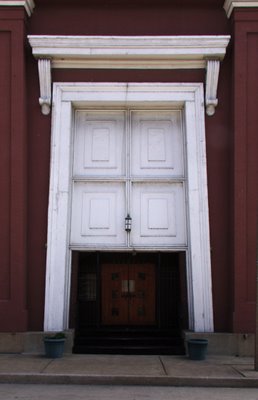
The chapel has an Egyptian door, which is quite unusual.
The architects of the church were George I. Barnett and Franz Saler. Barnett, considered the greatest of American classical architects, very many decades later would design the New Cathedral in Saint Louis.
The church is made of brick, manufactured on-site from local clay. The bricks, however, are not of good quality, and tend to crumble, due to excess water in the clay when they were fired. The bricks are now completely covered by a sealant. The church will need a similar sealant on the exposed woodwork of the door.
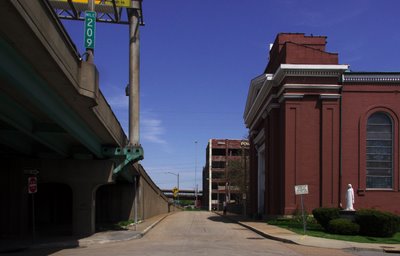
The chapel is right next to Interstate 55. The highway here takes a sharp right turn onto the Poplar Street Bridge, crossing over the Mississippi River to Illinois. I didn't notice any noise from traffic while inside, perhaps thanks to the building's massive brick construction.

Nave of the chapel. This was taken before the Communion and Liberation Way of the Cross procession started, on Good Friday.
The interior was designed by Professor Max Schneiderhahn, born in Germany, and the first professional liturgical artist in Saint Louis. His legacy of quality church art lasted until the early 1960s.

The apse over the sanctuary. The text around the half-dome says "OUR LADY OF VICTORIES, PRAY FOR US".
Our Lady of Victories is a title of the Blessed Virgin Mary, in honor of the defeat of the Ottoman fleet at the Battle of Lepanto. A massive Islamic navy was intent on a final, decisive invasion of Europe, and the Christians had no hope whatever of victory. Europeans, even Protestants, prayed the Rosary for a good outcome. Christendom won.

The altar of the chapel. Since this is no longer a regular parish, with only one Mass each week, it was not decorated for Holy Week.
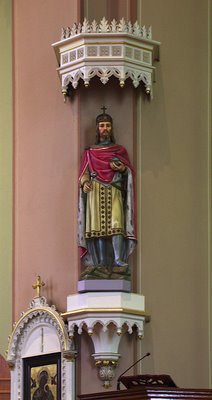
Saint Stephen, the first King of Hungary, who turned his tribal homeland into a Christian kingdom.
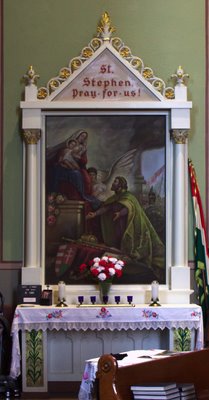
St. Stephen, Pray for us.
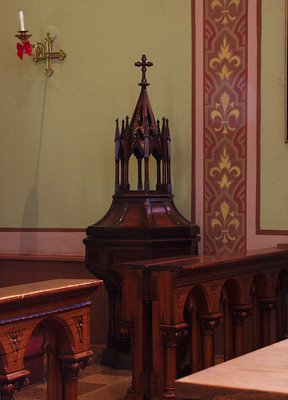
The baptismal font, located on the right side of the sanctuary.

Blessed Karl I of Austria, the last Emperor of Austria, and the last King of Hungary and Bohemia. He died in poverty, and was beatified in 2004.
Catholics who like democracy, capitalism, and secular governments are called neo-conservatives. On the contray, conservative Catholics want His Imperial and Apostolic Majesty sitting on the throne of a Catholic Kingdom.
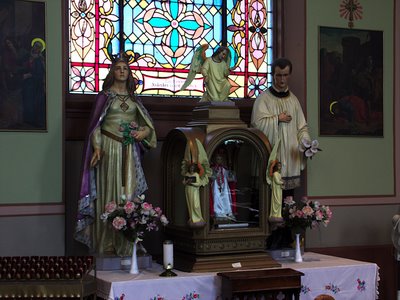
The Infant Jesus, flanked by Saint Elizabeth of Hungary and Saint Aloysius Gonzaga.
Both Saints were from nobility, lived in poverty, worked with the sick, and died young.
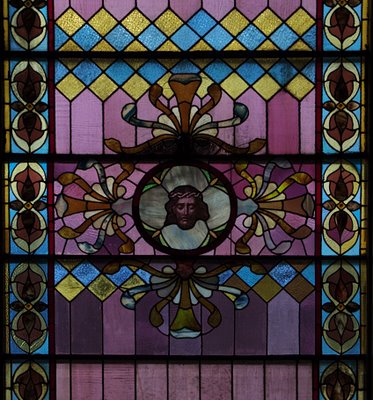
Detail of a stained glass window.
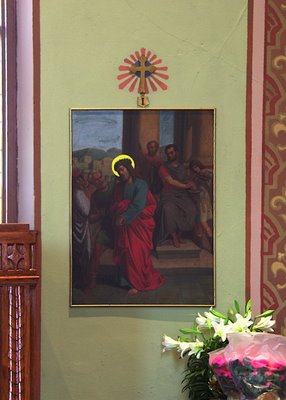
First station of the cross: Jesus is condemned. The Stations were painted by Max Schneiderhahn, who designed the rest of the interior of the church.

This is a new statue of Blessed Francis Xavier Seelos, a Redemptorist who preached at this church. He was born in Germany and ministered to German immigrants in the United States from 1843 to 1867. See http://www.seelos.org for more information. His beatification was one of the reasons why this church was not closed in 2005: this church may become a local shrine sometime in the future.
Blessed Seelos said "If the Americans were as expert in spiritual matters as they are in business affairs, all of them would be saints".
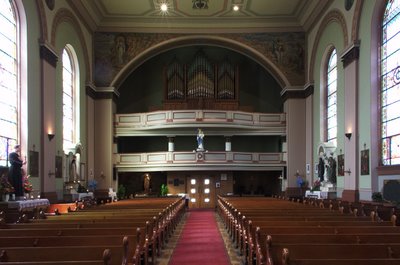
The chapel has two choir lofts. At one time, a convent of the Sisters of Saint Mary, a religious hospital order, was adjacent to this church. The Sisters were constanly exposed to infectious diseases—before antibiotics. They could sing in the choir without coming in contact with lay parishoners in the upper loft.
These are the oldest organ pipes in the city.

Lourdes grotto in the back of the chapel.
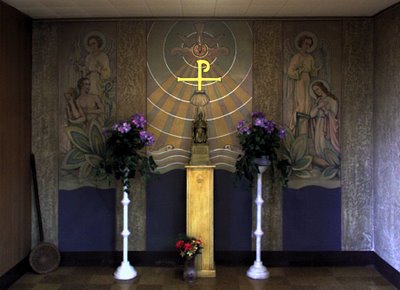
The Chair of Peter.

The chapel is in a gritty, industrial neighborhood. This is Chouteau's Landing, the earliest pioneer settlement in Saint Louis. The church was built on virgin land, never occupied by another structure. For a while, the church was surrounded by wooden houses built in the French style, of vertical wood construction, with wide verandas. During the great fire of 1849, this church was spared, but many nearby buildings were destroyed as firebreaks. The late 19th century saw increasing industrialization here; there are now no residential buldings in this area. There has been some recent talk of converting existing industrial buildings into condominiums.
Click for parish information at Archdiocesan website.
Address:
744 South Third Street
Saint Louis, Missouri 63102


This is simply a must see for those who love traditional churches. So much is original to its early days. Father Brian Harrison offers the Mass in latin on Sunday at 9;00 am. Please visit and support this wonderful place.
ReplyDeleteOne thing that stands out in my mind about this church is that it is literally 50 feet away from a major interstate artery in the St. Louis area but when you are in the church with the doors closed it is absolutely silent and you can not hear the traffic.
ReplyDelete